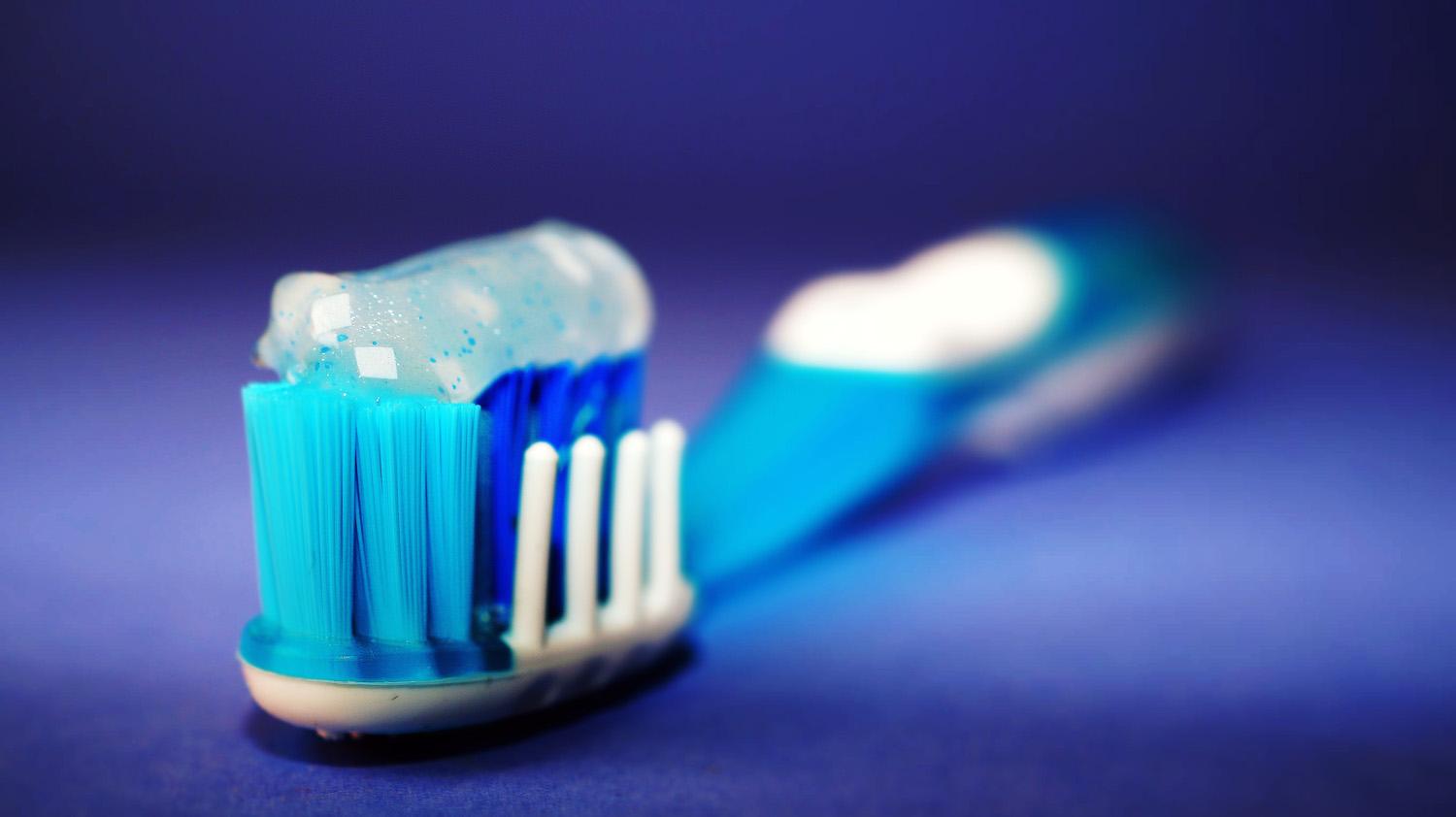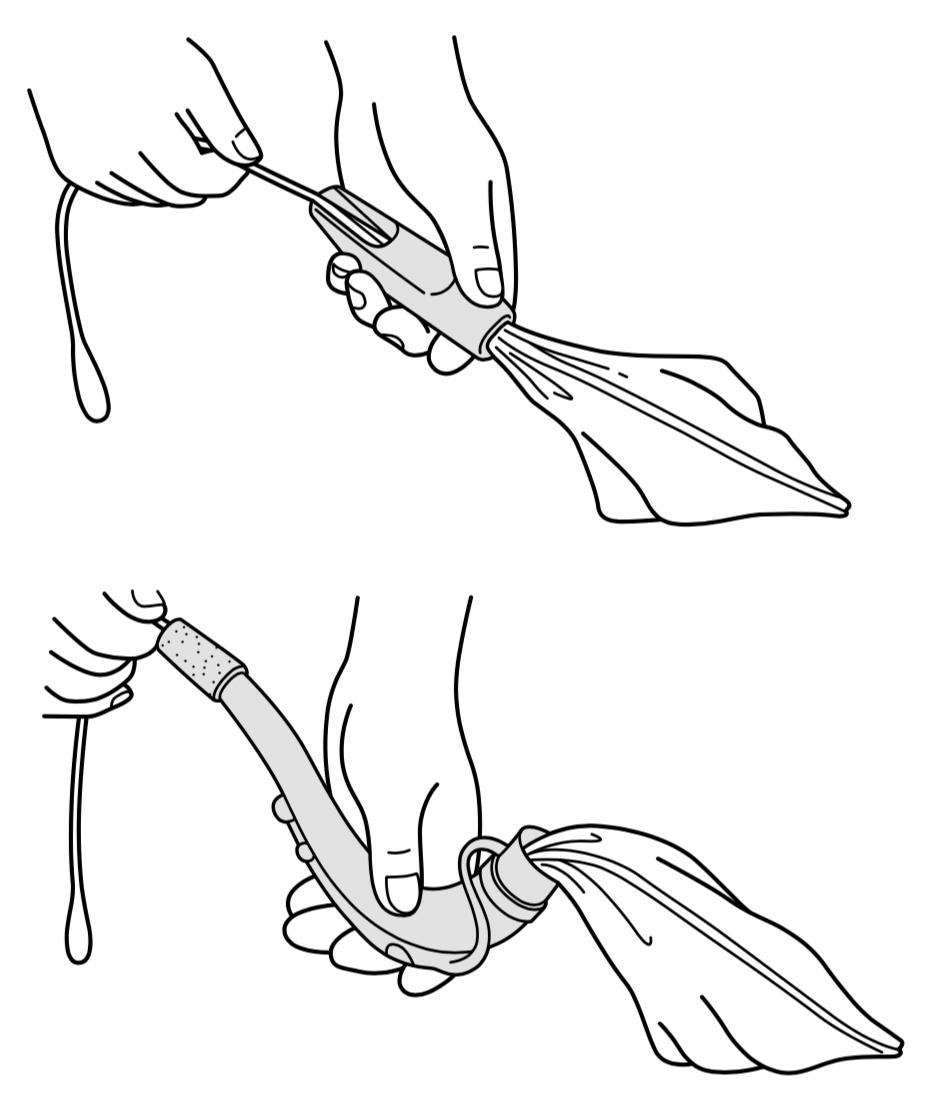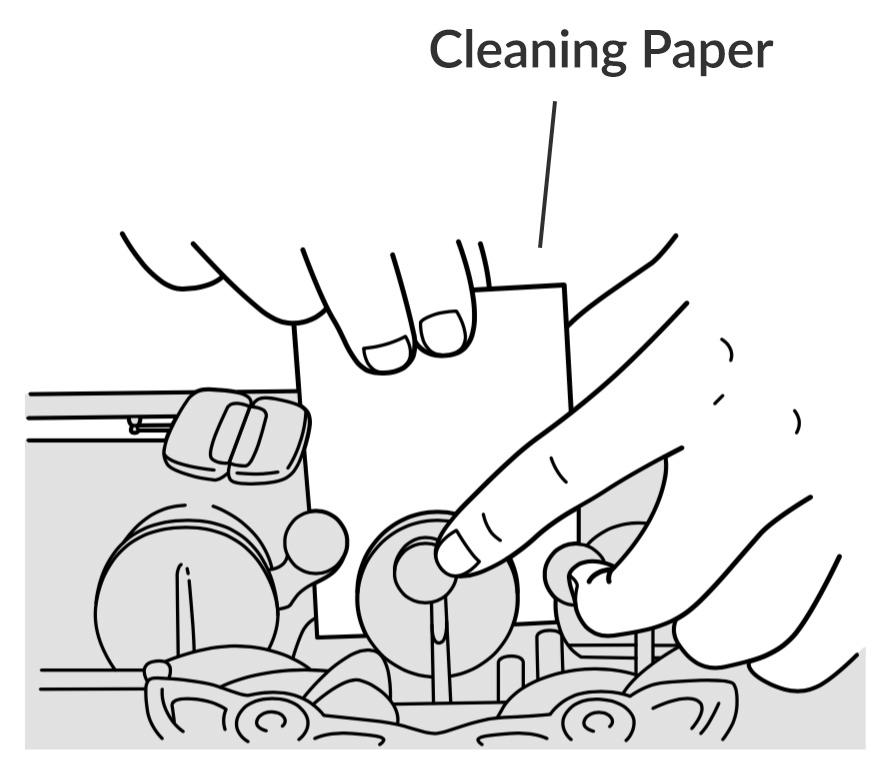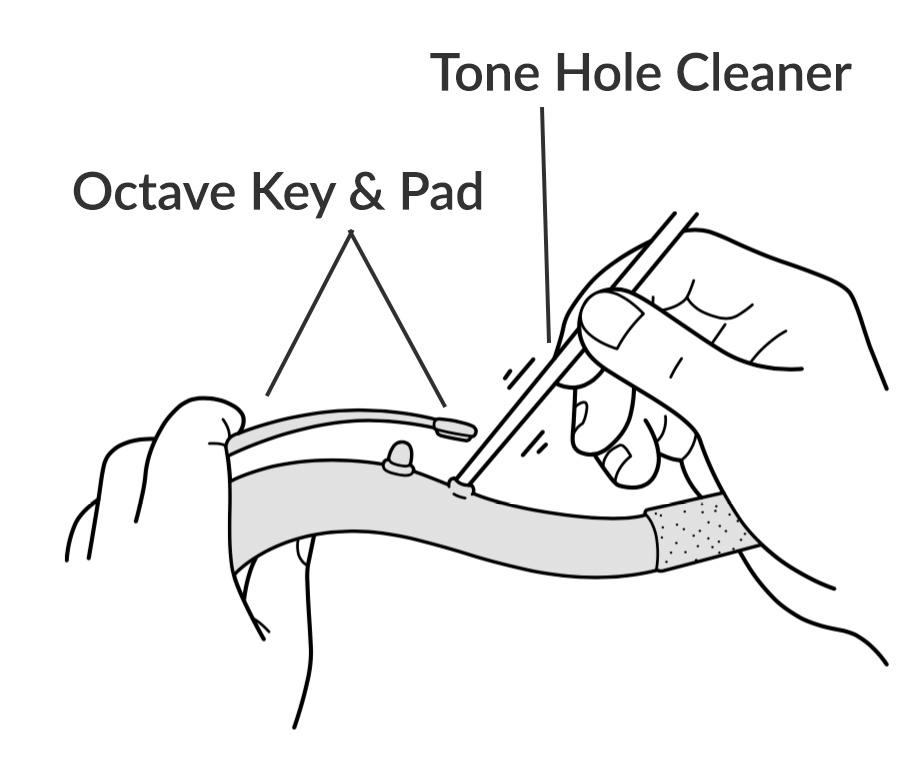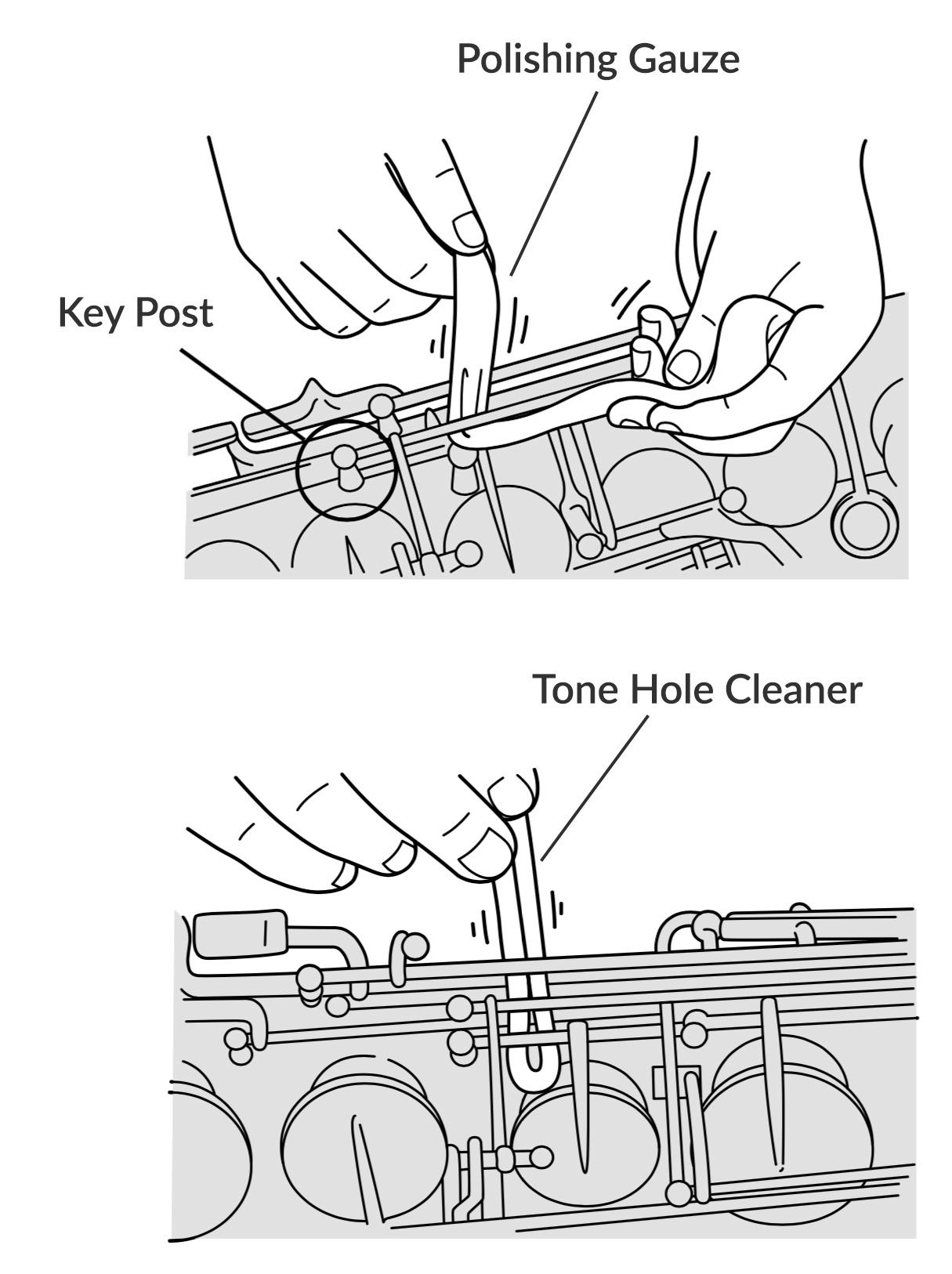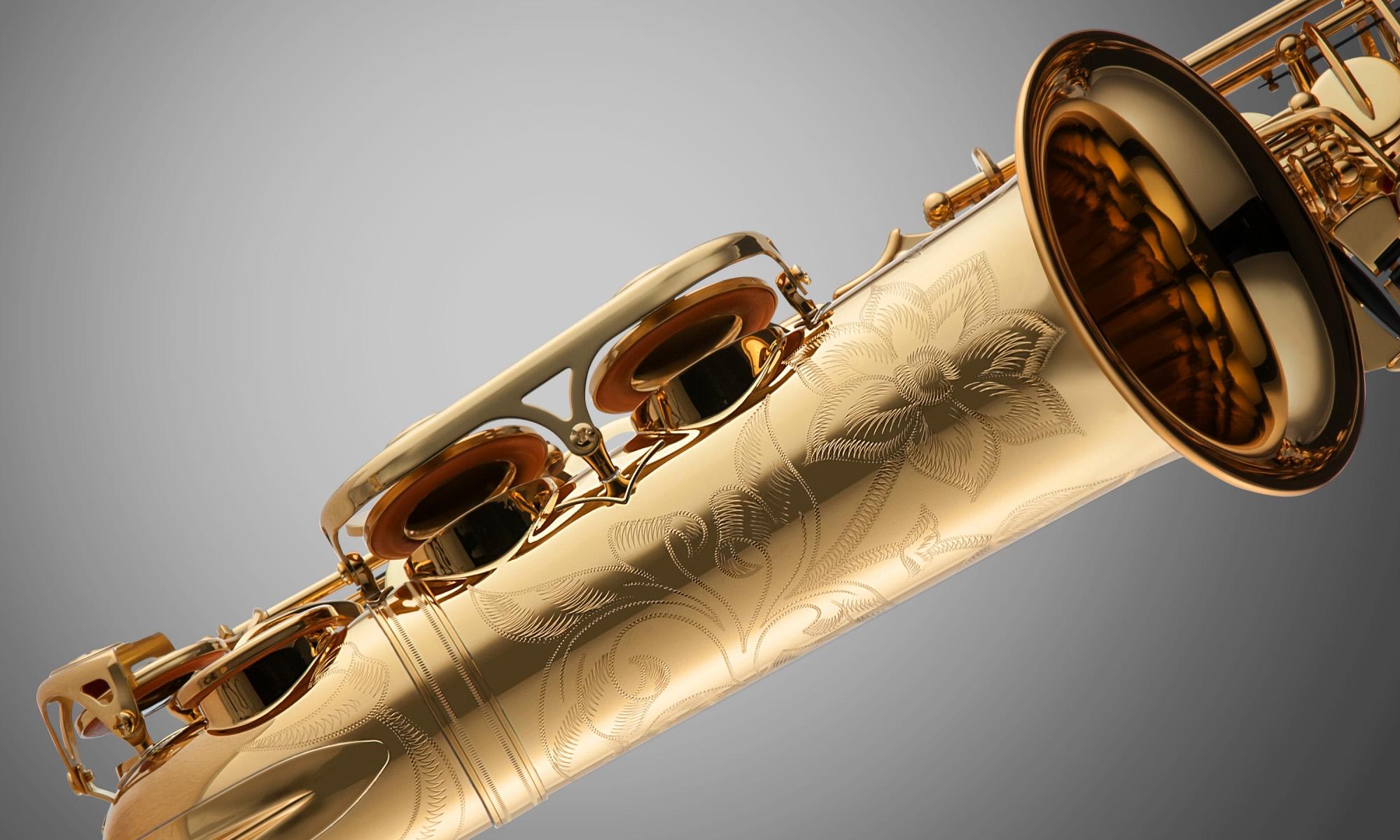
An Easy Guide to Saxophone Care & Maintenance
Most musical instruments require and benefit from regular care maintenance; look after your instrument and you'll be rewarded with optimal response and performance each time you practise or perform.
The saxophone is no exception. Carefully engineered and crafted from brass, the saxophone has an array of keys to precisely control the air moving within its body. Here's an easy guide to looking after your sax, followed by some recommended essentials to help you.
Contents:
- The different parts of a saxophone
- Before you play...
- After practising & performing - moisture removal
- Monthly maintenance
- Six-monthly servicing
- Yearly servicing
The Different Parts of a Saxophone
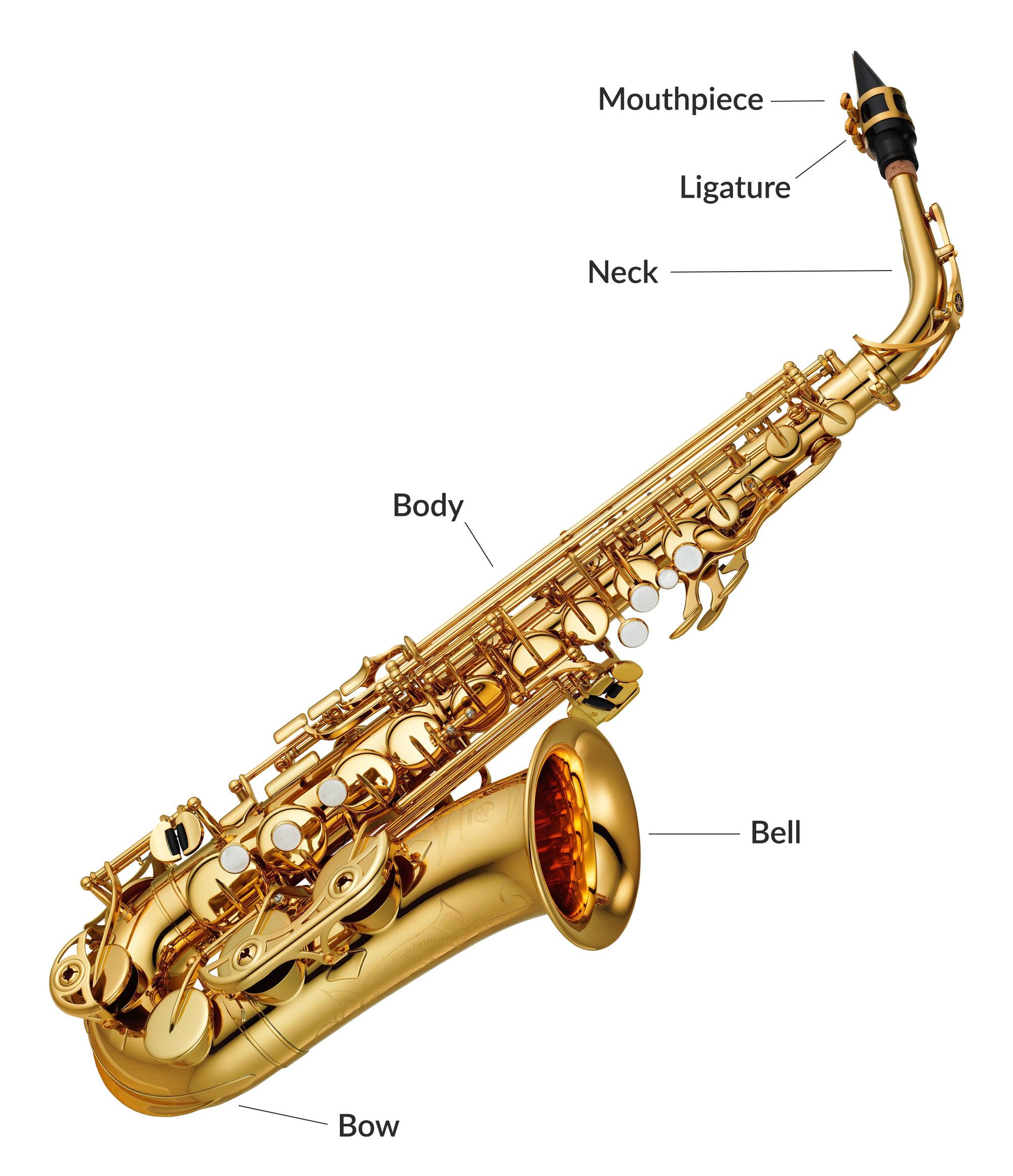
Most saxophone students begin to learn using an alto saxophone which has 5 sections, which disassemble into 3 or 4 parts:
- The mouthpiece, which includes a cane wood reed clamped over the air hole by a (usually) metal ligature. By blowing onto the reed in a certain way, you can make it vibrate which in turn makes the air within the saxophone vibrate as well - thus creating sound. Mouthpieces are available in either ABS resin or ebonite rubber with a range of sizes; a good 'all-round' mouthpiece is usually included with our saxophones.
- The neck, which the mouthpiece connects to and which is replaceable on most soprano, alto and tenor saxophones (but not usually replaceable on baritone saxes).
- The main body which includes most of the keys; the body includes a curved bow section on alto, baritone and tenor saxophones.
- The bell at the far end of the instrument; on alto, baritone and tenor saxophones, the bell projects upwards. On a soprano saxophone, the bell projects downwards and is almost always part of the main body; on alto, baritone and tenor saxophones, the bell is sometimes detachable.
At Yamaha, we make all our saxophones using brass (an alloy of around 70% copper and 30% zinc), usually coated in protective lacquer or plated with silver or gold.
Before you play...
Hand & Mouth Hygiene
Before playing, it's important to make sure your hands, face and teeth are clean; any residue on your skin can be detrimental to the saxophone's keys and body, whilst any food debris present in the mouth can easily find its way into the saxophone itself - which could block the airway and cause mould to grow.
Room Temperature & Humidity
Generally, if the saxophone has been stored at normal room temperature (19ºC - 21ºC) with a normal level of humidity, you should be able play it without concern. However, a saxophone's tone and pitch can be susceptible to more extreme temperatures whilst condensation can often occur when playing in cold environments (which can disrupt the air channel within the sax).
To protect against complications from temperature and humidity:
- Blow air through the saxophone prior to playing in order to warm it
- Use the palm of your hand to warm the saxophone's body
- Warm it gently and indirectly with a hand warmer or similar heat source, avoiding direct contact
- In warmer climates and environments, keep your saxophone away from sources of cold air (such as air conditioning and cooling fans)
Assembling the Saxophone

The joins between the mouthpiece, neck and main body use a layer of cork to make an air-tight seal, hence, a certain amount (but not an excessive amount) of effort is required to push the joints together. The neck receptor on the main body usually has a screw to loosen or tighten the connection.
Once assembled, attach a saxophone strap; adjust the strap after you've put it on.
Occasionally - more so when the saxophone is new - the cork joints may not seem to fit the adjoining tube at all. If this happens, apply a small amount of cork grease to the cork layer; this will reduce the cork's friction coefficient and allow you to assemble the saxophone.
- Only use a small amount of cork grease - too much will reduce the friction to the point where the saxophone body parts won't stay attached
- After playing and disassembling the saxophone, wipe the joins to remove any excess and un-absorbed cork grease; this stops the join collecting dust and protects the adhesive behind the cork
- Only use cork grease when necessary; applying it too regularly can dissolve the adhesive behind the cork
Preparing the Mouthpiece
A ready-to-play mouthpiece is made up of three parts - the resin or ebonite mouthpiece itself, a cane wood reed and a ligature which holds the mouthpiece and reed together. Once the saxophone body is assembled, put the reed into position:
- Take the reed from its holder or guard
- Place the flat side of the reed against the flat side of the mouthpiece; the thinner end of the reed should meet the thinner end of the mouthpiece
- The precise positioning of the reed is up to you - but usually the reed's tip would just cover or almost cover the mouthpiece tip
- Using your fingers to hold the reed in position, slide the ligature onto the mouthpiece and over the reed, so that the ligature's adjustment screws are directly over the thicker part of the reed
- Tighten the ligature's screws to clamp the mouthpiece and reed together
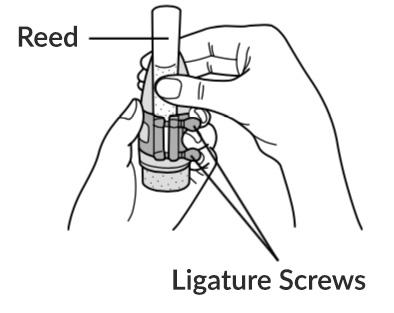
After Practising & Performing
After playing, it's essential to remove moisture from all parts of the instrument - including the main air channel, the reed and from the pads on the underside of the keys. Before doing so, detach the neck and mouthpiece; remove the reed and ligature from the mouthpiece.
Storing the Reed
Whilst excess water and saliva should be wiped off the reed after use, it's important not to let the reed dry out. Removing it from the mouthpiece and storing it in a reed guard should be sufficient, but take care not to let the reed's tip or vamp become damaged by the guard.
With regular practising and performing, a reed may only last for a fortnight before it starts to degrade and needs replacing. Keep spare reeds to hand, and make sure you're breaking in a new reed whilst using an already-broken in reed.
Removing Moisture from the Saxophone's Body
The main air channel that passes through the saxophone's body is where most moisture collects - it's important to remove it.
You'll need:
- Cleaning Swab
- Polishing Cloth
Follow these easy steps:
- Drop the swab's feeder cord through the widest end of the body section
- In turn, gently and slowly use the feeder cord to pull the swab fully through the bell, body and neck - but only pull the swab partially through the mouthpiece (making sure the reed has already been removed)
- If the swab appears to get caught on anything, slow down and if necessary, gently pull the swab back out
- Repeat to collect all excess moisture
- Wipe around each joint using a polishing cloth to remove any moisture and excess grease from the joint and cork
- Use a polishing cloth to wipe down the outer surface
- Repeat steps 1 to 5 for each body section
Removing Moisture from the Saxophone's Key Pads
Moisture can also collect on the pads underneath the keys - particularly covered keys (those which are a single flat surface without a hole. It's important to remove this moisture to stop the pads from deteriorating.
You'll need:
- Cleaning Paper
- Powder Paper
Follow these easy steps:
- Place cleaning paper between the pad and the tone hole
- Hold the paper firmly in position
- Lightly and slowly press down the key so that the pad under the key makes contact with the paper
- Keep the key pressed for a few seconds so the paper can absorb moisture from the pad
- Remove the paper only when the key isn't pressed down
- Repeat 2 to 3 times, using different areas of the paper
- If the pads seem to be at all sticky (after moisture has been removed):
- Take a clean sheet of powder paper from the packet
- Dab the surface of the pad several times with the powder paper
Cleaning the Octave Tone Hole
What you'll need:
What to do:
- Press down on the octave key to lift the pad and reveal the octave tone hole
- Use a tone hole cleaner to remove any dirt or dust from the tone hole
Monthly Maintenance
Whilst there's no need for a full service every day, we recommend giving your saxophone some extra attention at least once a month:
Cleaning Between the Keys:
What you'll need:
- Polishing Gauze
- Tone Hole Cleaners
Follow these easy steps:
- Use polishing gauze to remove dirt and dust from the surfaces of keys and key posts
- Using a tone hole cleaner, remove any dirt or dust from the spaces between the keys, pads and body
- Take care not to bend any keys, posts or arms
Lubricating the Saxophone's Keys
The keys on the saxophone have been precisely designed and engineered to allow control over pitch and tone when you play. But as with any mechanism, it's important to check they're in good working order.
What you'll need:
- Small electrical screwdriver set
- Instrument key oil
- Clean, lint-free cloth
Follow these easy steps:
- Using an appropriate small screwdriver, gently check the screws are tight for each key lever and arm
- Look out for any which show signs of discolouration or disfigurement and replace if possible
- Apply a small amount of key oil to the moving parts of the keys
- Be careful not to use too much oil
- After applying, press down each keys to allow the oil to spread into the lever mechanism
- Wipe off any excess oil from the surface of the body, joints or keys
Six-Monthly Neck Cleaning
To keep the saxophone's neck performing optimally, it should be cleaned every six months:
You'll need:
- Brass Soap
- Lukewarm Water
- Saxophone Neck Brush
- Small Electrical Screwdrivers
- Adhesive Tape
- Cleaning Swab
What to do:
- Make a lukewarm (30ºC - 40ºC) soap solution mixing brass soap with water at a ratio of around 1:10
- Don't put the saxophone neck directly into the solution
- Use a small screwdriver to remove the key from the neck
- Wrap adhesive tape around the cork to prevent it getting wet
- Apply some of the soap solution to the neck brush and scrub the neck's interior
- Once the brush seems to have removed most of the dirt, rinse the brush with clean water and scrub the neck interior with water to remove the brass soap solution and any remaining dirt
- Dry the neck interior with a cleaning swab (with a soprano saxophone neck, don't try to pull the swab all the way through the neck interior)
- Dry the neck exterior with a polishing cloth
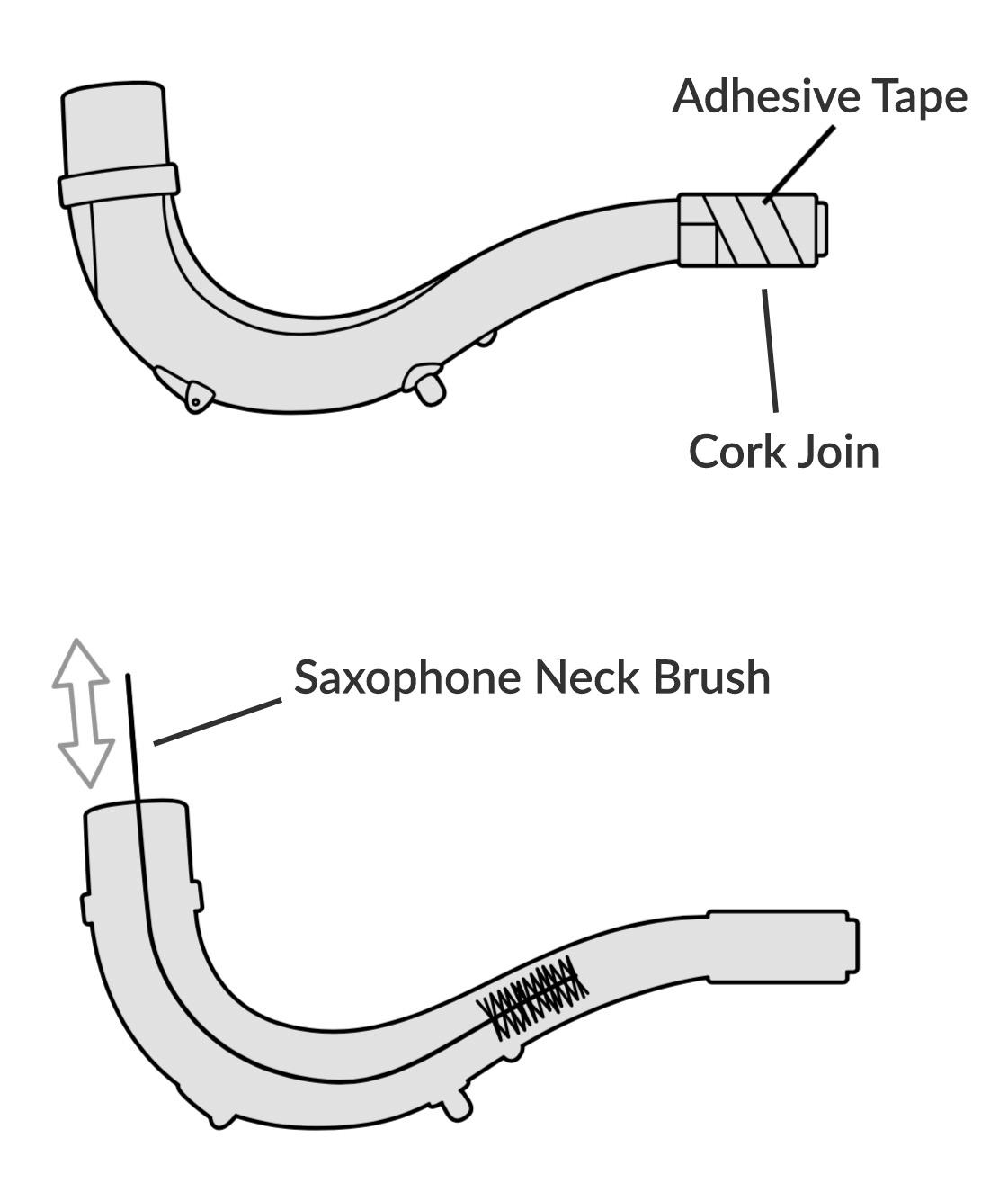
Yearly Servicing
During a full service, a saxophone is completely disassembled and thoroughly cleaned - giving the opportunity for any damage or wear to be discovered and addressed.
Assuming normal daily and monthly care is given to your saxophone, we'd recommend having your sax serviced by a qualified saxophone technician once every year.



